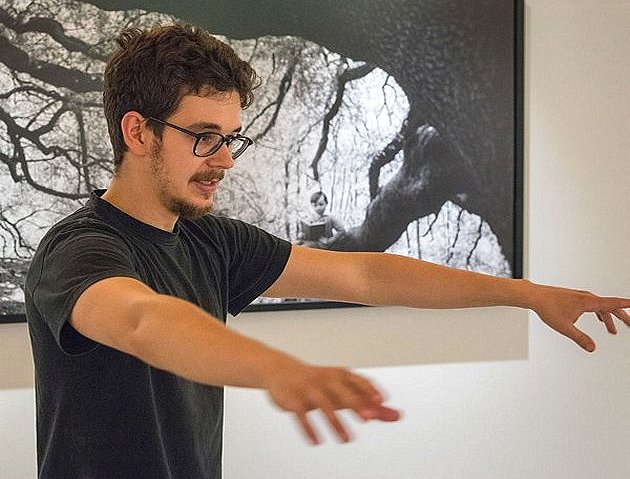ART, WHATEVER IT TAKES
Since the early pandemic in 2020, Rome Art Program has conducted a series of interviews, “Art, Whatever It Takes.”
Artists, Art Critics, and Art Historians living in Italy, the U.S., and U.K., share their insights during these powerful times.

Interview with Olmo Amato
Olmo Amato was born in Rome in 1986. After earning a M.Sc. in Neurobiology, he dedicated himself to photography, filmmaking & experimentation with digital manipulation techniques. He utilizes analog & digital photography techniques, combining through photomontage archival photos, original shots & artificially generated images.
RomeArtProgram: What is your definition of “art” today?
Olmo Amato: I view art as a dynamic means of exploring the complexity of reality and its relationship with a person’s inner world. A way to express a personal point of view on contemporary issues.
RAP: Art is dynamic and regenerates itself… how does it change, and how did it change us?
Olmo: Art undergoes a continuous metamorphosis in response to shifts in society, technology, and culture. These transformations not only reshape our perceptions and interactions with art but also push the boundaries of our understanding, prompting us to reevaluate our preconceptions and broaden our horizons.
RAP: When (and how) did you understand that art was becoming very important in your life?
Olmo: I realised this when I understood that I could rediscover the joy of childhood, play with photographic images, and experience that almost childlike wonder when faced with the things and new narrations I could create.
RAP: What role does art play today? What are the “great figures” who have recently changed it? Do you feel close to any of these figures?
Olmo: Art plays a crucial role in mirroring, interrogating, and potentially influencing the future of society. I greatly admire artists who push the boundaries of conventional artistic mediums and communicate directly, free from filters or the necessity of an “interpreter.”
RAP: Are there still traditional figures such as collectors, muses, mecenate and patrons, in today’s art and society interaction model?
Olmo: Yes, there are, and there are many.
RAP: How have the new technologies and media culture changed art today, improving or worsening it…? What do you feel are your biggest challenges?
Olmo: Embracing new technologies should not be viewed as inherently negative. The pivotal factors lie in how we employ these tools, the idea behind an artwork, and the awareness of how we use these tools within our medium of expression.
As an artist and photographer, I have recently ventured into the realm of cutting-edge technologies, such as AI text-to-image generative models. My foremost challenge at present is to fathom how these synthetic images can contribute to our comprehension of the world and our overarching connection with art and digital images.
RAP: Art as a mirror of man, in this moment of emergency seems to be shattered …what do these fragments reflect now?… Shadow or light of the moment?
Olmo: Art serves as a reflection of contemporary crises. Through my work, I aim to shed light on important ecological and technological concerns. We see both shadows and light, and we should focus on the bright pieces to build a better future.
RAP: Understanding, interpreting, and then possibly judging the work of art; which is the right path when we are in front of a piece of art?
Olmo: Art appreciation is a subjective and personal experience. An emotional response is essential to connect to it, but awareness of the artist’s historical and cultural context would help interpret and judge art.
RAP: What is the real role of Academies and Art schools today? What can artists learn from these institutions today?
Olmo: Art education offers a structured platform for artists to hone their skills, increase their knowledge and explore new technologies. I have immense respect for those artists who have thrived in this organised environment, but I appreciate even more the work of those who didn’t. However, my journey falls into this different category. I pursued studies in science and neurobiology, gradually venturing into the realm of art through an unconventional and self-directed path. This unique route granted me the freedom to explore diverse and seemingly distant domains.
RAP: Art too has undergone a complex process of globalization; can having an authentic and genuine style be an advantage or a drag for an artist?
Olmo: Having a distinct, unique style can definitely be an advantage in the global art landscape.
RAP: How do Art Galleries and Museums position themselves today, and, in your opinion, how should they?
Olmo: Art galleries and museums should remain adaptable, embrace changing artistic forms, and consider incorporating interactive exhibitions to engage the audience effectively. Art in a museum should be alive and dynamic.
RAP: “Figurative” or “Abstract” ? Which of the two is better descriptive of the period we live in? Which one will have a better future?
Olmo: In our contemporary art landscape, figurative and abstract elements should find a way for coexistence. Dynamic hybridisation, synergy and symbiosis are the terms I would choose to describe the future of Art.
RAP: Today we often speak of “emerging artists”; what advice based on your experience do you feel you can give to young artists?
Olmo: Young artists should explore interdisciplinary approaches, push the boundaries of their art, and strive to find a unique voice by merging different fields and utilising available technological resources in new and unconventional ways.
RAP: Art as a lens for reading the present, can it modify the space and time we pass through? …will art save us?
Olmo: Art can illuminate pressing ecological, political, and technological issues, acting as a mirror reflecting the challenges and opportunities of our time. While art can inspire change and raise awareness, without concrete and organised actions, it alone will not save us. However, art can guide us toward a better future, but it won’t carry us there.
olmoamato.it
